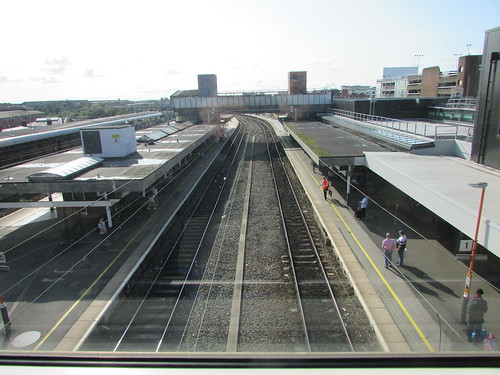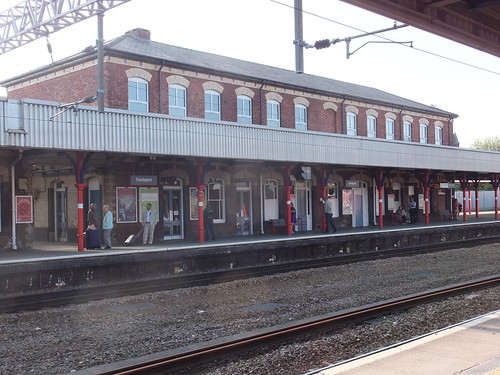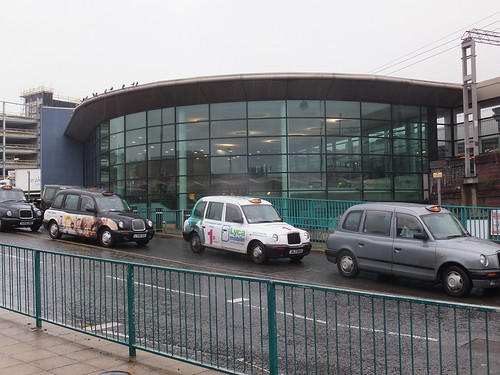Timetables and operations have been altered because of the Covid Pandemic and I was quite surprised to see how busy services were, operated in both directions by two 4-car Class 221 coupled together
For many years I was a volunteer at Manchester's Museum of Science and Industry (there are a number of posts here), so I was a frequent traveller both by road or by train to Manchester. By train, I used the routes through either Stoke-upon-Trent or Crewe which normally called at Stockport. But, my most recent train journey to or through Stockport was some time ago so I welcomed a chance to see what had changed. Not much, it appeared. Since Avanti West Coast took over the 'Pendolino' services between London and Manchester from Virgin, they have also taken over management of Stockport station but, of course, they host the services of a number of other Train Operating Companies, including 'CrossCountry'.
I won't repeat my distaste for the 'new' (and still incomplete) Wolverhampton station. Fortunately, I didn't have long to wait on draughty platform 2 for my train. The rather modest accommodation on island platform 2/3 with simple, flat canopies remains as constructed by British Railways, albeit with some internal modernisation.

Wolverhampton Station: view from second overbridge looking towards Birmingham showing left platform 2, right platform 1. There was formerly a Middle Siding between the two tracks for which the overhead catenary remains (Blackpool by Electric Train)
I found my reserved seat (a couple who'd commandeered my seat sheepishly apologised and immediately moved elsewhere). The journey to Stockport was incident-free and on time but I'm still not a great fan of the Bombardier design. The Class 221 has 'tilting technology' to allow higher maximum speed but I understand it was taken out of use years ago to limit maintenance costs. Allowance for the six degrees of tilt either way results in the body being narrower at roof level that floor level, giving a distinctly 'narrow-bodied' feel to the passenger compartment.
Each coach has a Cummins QSK19 underfloor-mounted 6-cylinder, 6-litre turbo diesel driving an electric generator to power one traction motor on each bogie. To generate 750 h.p., the engine is run at up to 1800 r.p.m. which I find generates uncomfortable noise and vibration. Dellner autocouplers are provided.

'Cross Country' Voyager in 2010: detail of Dellner autocoupler with twin horns below.
Approaching Stockport, the appearance of the London and North Western designed signal box at Edgeley Junction Number 1 always makes me smile. In general, the route from Euston to Manchester is now commanded by a chain of modern Railway Operating Centres and Signalling Control Centres but, through Stockport, the main line is still controlled by a group of venerable signal box structures, even if now bereft of their original mechanical signalling equipment. These are Edgeley Junction No. 1 (where the line from Buxton converges), Edgeley Junction No. 2 (where the line from Chester converges), Stockport No. 1 (south end of station) and Stockport No. 2 (north end of station). Nearer Manchester, Heaton Norris Junction, a more modern brick structure retaining a mechanical frame survived for some years but has now been abolished.

Edgeley Junction No. 1 signal box.
Stockport station is a strange amalgam of two very-recognisable London and North Western station buildings on island platforms 1/2 and 3/4 (internally modernised) which lead via a subway to a modern booking hall on the town side which gives access to a 'new' platform.
The 'new' platform is numbered '0' and unusual platform numbering, including the use of '0', intrigues me. There are a couple of posts here and here on the topic.
Stockport: View from platform 0 looking towards Crewe in 2013 showing two '0' platform signs (the smaller '4' sign is the stop marker for 4-coach trains).

Stockport: View from platform 3 in 2013 showing the LNWR station building on platform 1/2.

Stockport: View from platform 0 looking towards Crewe in 2013 showing the LNWR station building on platform 1/2.

Stockport: View from platform 2 looking towards Manchester in 2013 showing the LNWR station building on platform 3/4.

Stockport: Modern station building on Up side in 2013.
After my meeting, I returned to Stockport station with less than ten minutes to wait for a Southampton-bound 'Cross Country' which would deliver me back to Wolverhampton in around one hour. Being a Friday and late afternoon, the train was very full but I managed to find an unused seat so that wasn't too bad at all.
Related posts in this blog
The Buxton Branch.
Zen and the Art of Platform Numbering.
Platform Numbering Revisited.
My pictures
Pictures taken on earlier travels in Stockport area are here:-
Manchester Area Rail

